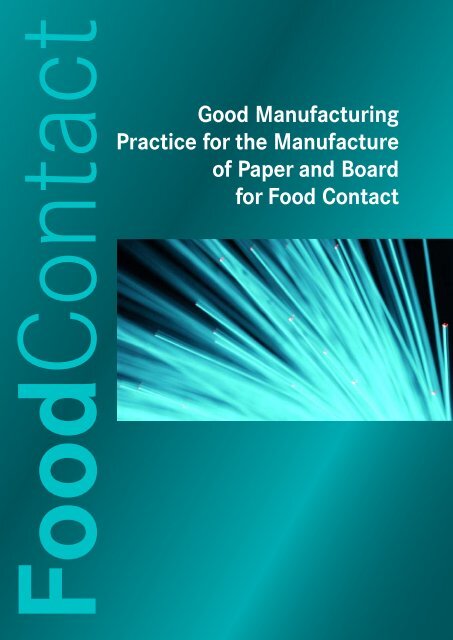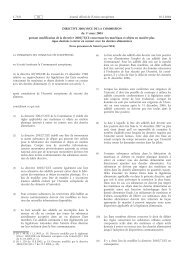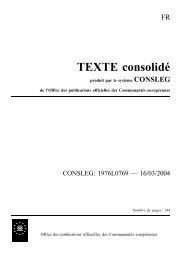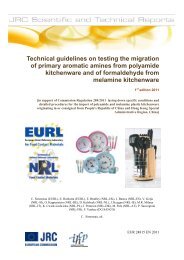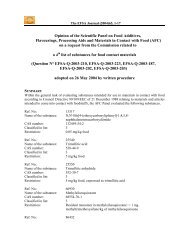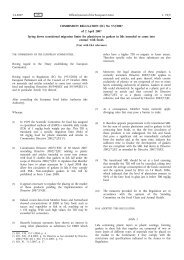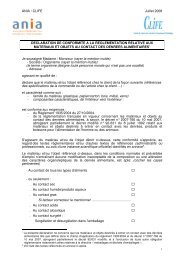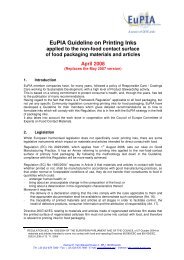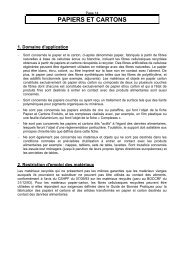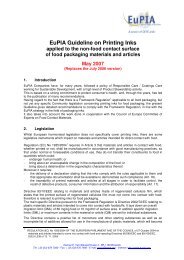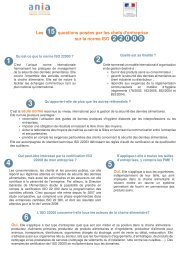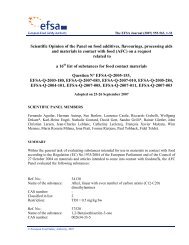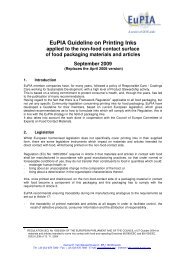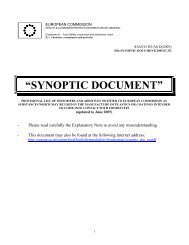Good Manufacturing Practice for the Manufacture of Paper - CEPI ...
Good Manufacturing Practice for the Manufacture of Paper - CEPI ...
Good Manufacturing Practice for the Manufacture of Paper - CEPI ...
Create successful ePaper yourself
Turn your PDF publications into a flip-book with our unique Google optimized e-Paper software.
FoodContact<br />
<strong>Good</strong> <strong>Manufacturing</strong><br />
<strong>Practice</strong> <strong>for</strong> <strong>the</strong> <strong>Manufacture</strong><br />
<strong>of</strong> <strong>Paper</strong> and Board<br />
<strong>for</strong> Food Contact<br />
1
<strong>Good</strong> <strong>Manufacturing</strong><br />
<strong>Practice</strong> <strong>for</strong> <strong>the</strong> <strong>Manufacture</strong><br />
<strong>of</strong> <strong>Paper</strong> and Board<br />
<strong>for</strong> Food Contact<br />
Issue 1 - September 2010<br />
<strong>CEPI</strong> is publishing this document as <strong>the</strong>re is a need to provide papermaking <strong>Good</strong> <strong>Manufacturing</strong><br />
<strong>Practice</strong> in order to complement <strong>the</strong> contents <strong>of</strong> <strong>the</strong> recently published Industry Guideline 1 .<br />
The document contains a number <strong>of</strong> new concepts and methodologies, <strong>the</strong> detailed operation<br />
<strong>of</strong> which may be unfamiliar to some users. GMP is an essential part <strong>of</strong> <strong>the</strong> production <strong>of</strong> food<br />
contact paper and board and <strong>CEPI</strong> considers it essential that <strong>the</strong> principles contained in <strong>the</strong><br />
document are accurate and practical, an ambition which cannot be fully realised until extensive,<br />
practical experience has been gained. <strong>CEPI</strong> would, <strong>the</strong>re<strong>for</strong>e, welcome feedback on <strong>the</strong><br />
operation <strong>of</strong> this GMP both from paper manufacturers and o<strong>the</strong>r interested stakeholders such as<br />
customers and regulatory authorities with a view to its review and revision by <strong>the</strong> end <strong>of</strong> 2011.<br />
1. Industry Guideline <strong>for</strong> <strong>the</strong> Compliance <strong>of</strong> <strong>Paper</strong> and Board Materials and Articles <strong>for</strong> Food Contact, published on 18 May 2010 and<br />
available at http://www.cepi.org/Objects/1/files/Industry%20guideline-final.pdf
TABLE OF CONTENTS<br />
1. Introduction 1<br />
2. Scope 1<br />
3. Definitions (as apply in <strong>the</strong> context <strong>of</strong> this GMP) 2<br />
4. Quality Assurance 3<br />
5. Quality Control System 5<br />
6. Traceability 5<br />
7. Documentation 5<br />
8. Related Standards 6<br />
9. Detailed requirements <strong>for</strong> Compliance with <strong>the</strong> GMP Regulation 6<br />
Diagrams<br />
Table 1 - Definitions 2<br />
Figure 1 - Principles <strong>of</strong> Control 3<br />
Table 2 - Elements <strong>of</strong> <strong>the</strong> <strong>Paper</strong>making GMP System 7<br />
Figure 2 - Schematic Representation <strong>of</strong> <strong>the</strong> <strong>Paper</strong>making Process 13<br />
Figure 3 - Severity <strong>of</strong> Risk 14<br />
Figure 4 - Steps in <strong>the</strong> Risk Assessment Process 16<br />
Figure 5 - Flow Chart <strong>for</strong> <strong>Paper</strong>making Process 17<br />
Figure 6 - Risk Calculation Matrix 17<br />
Table 3 - Examples <strong>of</strong> Documentation <strong>of</strong> Hazards and <strong>the</strong>ir Associated Remedial Actions 19<br />
Table 4 - Glossary <strong>of</strong> Terms (applicable to <strong>the</strong> Traceability Guidelines) 26<br />
Figure 7 - <strong>Paper</strong> & Board <strong>Manufacture</strong> - Flow Diagram 27<br />
Annexes<br />
Annex 1 - Area Covered by this GMP 13<br />
Annex 2 - Hazard Inventory and Risk Analysis 14<br />
Annex 3 - Guidelines <strong>for</strong> Responsible Sourcing and Supply <strong>of</strong> Recovered <strong>Paper</strong> 21<br />
Annex 4 - Traceability in <strong>the</strong> paper and board packaging chain 24
1. INTRODUCTION<br />
It is a requirement <strong>of</strong> <strong>the</strong> Regulation (EC) No 1935/2004, on materials and articles intended to<br />
come into contact with food (<strong>the</strong> Framework Regulation), that all materials and articles intended<br />
<strong>for</strong> food contact shall be manufactured in accordance with <strong>Good</strong> <strong>Manufacturing</strong> <strong>Practice</strong> (GMP).<br />
The components and principles <strong>of</strong> such a GMP are described in Commission Regulation (EC) No<br />
2023/2006 on good manufacturing practice <strong>for</strong> materials and articles intended to come into<br />
contact with food (<strong>the</strong> GMP Regulation).<br />
Because <strong>the</strong> GMP Regulation applies to all types <strong>of</strong> food contact materials and articles, <strong>the</strong>re is<br />
a need <strong>for</strong> specific advice on its implementation in each manufacturing sector. This paper and<br />
board GMP gives that implementation advice <strong>for</strong> <strong>the</strong> paper and board manufacturing industry.<br />
In accordance with <strong>the</strong> definition <strong>of</strong> GMP given in Section 3, it does not contain details <strong>of</strong><br />
manufacturing limits and quality standards which are normally contained in national legislation,<br />
customer specifications and o<strong>the</strong>r quasi-legislative measures.<br />
2. SCOPE<br />
This GMP reference document is intended to provide guidance on how to fulfil <strong>the</strong> requirements<br />
<strong>of</strong> <strong>the</strong> GMP Regulation in <strong>the</strong> manufacturing <strong>of</strong> paper and board intended to come into contact<br />
with foodstuffs. It does not cover <strong>the</strong> operations <strong>of</strong> converters.<br />
The contents <strong>of</strong> this document assume that operators have in place <strong>the</strong> ISO 9001 quality<br />
management system or equivalent in place.<br />
The document applies to <strong>the</strong> manufacturing <strong>of</strong> paper and board suitable <strong>for</strong> contact with all types<br />
<strong>of</strong> foodstuff and conditions <strong>for</strong> its use.<br />
The document covers <strong>the</strong> entire production process as outlined in Annex 1. Preventive measures<br />
are based on <strong>the</strong> intended use <strong>of</strong> <strong>the</strong> end product.<br />
This document contains two main, operational parts. Firstly, Sections 4 - 8 describe <strong>the</strong> basic<br />
requirements <strong>of</strong> <strong>the</strong> GMP Regulation and how <strong>the</strong>y are to be interpreted and applied during<br />
paper production. Secondly, Section 9 contains a list <strong>of</strong> detailed actions which interpret <strong>the</strong>se<br />
requirements <strong>for</strong> adoption within <strong>the</strong> paper and board manufacturing area in order to achieve<br />
compliance with <strong>the</strong> GMP Regulation.<br />
As <strong>the</strong> situation may be different in paper mills depending on <strong>the</strong> raw material, <strong>the</strong> paper<br />
produced, <strong>the</strong> size <strong>of</strong> <strong>the</strong> manufacturing facility, etc., <strong>the</strong>ir various needs to fulfil <strong>the</strong> GMP<br />
Regulation may be different and not all <strong>the</strong> measures described in Section 9 may be needed.<br />
Consequently, advice on <strong>the</strong> need <strong>for</strong> <strong>the</strong> different measures is given.<br />
1
3. DEFINITIONS (as apply in <strong>the</strong> context <strong>of</strong> this GMP)<br />
Table 1 - Definitions<br />
Additives<br />
BfR Recommendation 36<br />
Control Point<br />
Dosing equipment<br />
EN 643<br />
External contractors<br />
Framework Regulation<br />
GMP Regulation<br />
<strong>Good</strong> <strong>Manufacturing</strong> <strong>Practice</strong><br />
Hazard<br />
Hygiene<br />
Jumbo reel<br />
Labelling<br />
Organoleptic<br />
Point <strong>of</strong> Concern<br />
Quality Assurance System<br />
Quality Control System<br />
Substances, o<strong>the</strong>r than fibre and minerals, which are added to <strong>the</strong><br />
papermaking process to achieve ei<strong>the</strong>r an improvement in that<br />
process or <strong>the</strong> modification <strong>of</strong> <strong>the</strong> properties <strong>of</strong> <strong>the</strong> product.<br />
A document produced by <strong>the</strong> German Federal Institute <strong>for</strong> Risk<br />
Assessment <strong>for</strong> <strong>the</strong> control <strong>of</strong> manufacture <strong>of</strong> food contact paper and<br />
board.<br />
The identified risk at that point should be controlled by a specific<br />
measure (<strong>for</strong> example a specific temperature, a specific process time,<br />
a specific dosage, etc.).<br />
Equipment which automatically controls <strong>the</strong> addition <strong>of</strong> liquids or<br />
solids to <strong>the</strong> papermaking process.<br />
European list <strong>of</strong> standard grades <strong>of</strong> recovered paper and board.<br />
Companies which are commercially separate from <strong>the</strong> one operating<br />
<strong>the</strong> paper mill and which per<strong>for</strong>m tasks within that paper mill.<br />
Commission Regulation (EC) No 1935/2004 on materials and articles<br />
intended to come into contact with food.<br />
Commission Regulation (EC) No 2023/2006 on good manufacturing<br />
practice <strong>for</strong> materials and articles intended to come into contact with<br />
food.<br />
<strong>Good</strong> <strong>Manufacturing</strong> <strong>Practice</strong> means those aspects <strong>of</strong> quality<br />
assurance which ensure that materials and articles are consistently<br />
produced and controlled to ensure con<strong>for</strong>mity with <strong>the</strong> rules<br />
applicable to <strong>the</strong>m and with <strong>the</strong> quality standards appropriate to <strong>the</strong>ir<br />
intended use.<br />
A biological, chemical or physical agent in, or condition <strong>of</strong>, food<br />
contact materials with <strong>the</strong> potential to cause an adverse health effect.<br />
Elements <strong>of</strong> <strong>the</strong> condition <strong>of</strong> humans and premises which could<br />
influence <strong>the</strong> safety <strong>of</strong> food contact paper and board. These could<br />
include, <strong>for</strong> instance, disease, bacteria, dirt, pests, insects, etc.<br />
A reel <strong>of</strong> paper produced directly at <strong>the</strong> end <strong>of</strong> a paper machine be<strong>for</strong>e<br />
any slitting or sheeting operations have been per<strong>for</strong>med.<br />
The affixing <strong>of</strong> identification to reels and packets <strong>of</strong> paper or board.<br />
Relating to smell, texture, appearance or taste <strong>of</strong> food and detectable<br />
by human senses.<br />
The risk at that point should be controlled by a general measure,<br />
applied to <strong>the</strong> whole process as a preventive measure.<br />
The total sum <strong>of</strong> <strong>the</strong> organised and documented arrangements made<br />
with <strong>the</strong> purpose <strong>of</strong> ensuring that materials and articles are <strong>of</strong> <strong>the</strong><br />
quality required to ensure con<strong>for</strong>mity with <strong>the</strong> rules applicable to<br />
<strong>the</strong>m and <strong>the</strong> quality standards necessary <strong>for</strong> <strong>the</strong>ir intended use.<br />
The systematic application <strong>of</strong> measures established within <strong>the</strong> quality<br />
assurance system that ensure compliance <strong>of</strong> starting materials and<br />
intermediate and finished materials and articles with <strong>the</strong> specification<br />
determined in <strong>the</strong> quality assurance system.<br />
2
Recovered paper<br />
Risk<br />
Risk analysis<br />
Stock preparation<br />
<strong>Paper</strong> or board, o<strong>the</strong>r than internal broke or scrap, which is recovered<br />
from an operation within <strong>the</strong> paper supply chain and returned to a<br />
paper mill <strong>for</strong> conversion back into new paper.<br />
A function <strong>of</strong> <strong>the</strong> probability <strong>of</strong> an adverse health effect and <strong>the</strong><br />
severity <strong>of</strong> that effect, consequential to a hazard(s) in a food contact<br />
material.<br />
The process <strong>of</strong> defining <strong>the</strong> various threats to product safety,<br />
determining <strong>the</strong> extent <strong>of</strong> vulnerabilities and devising appropriate<br />
countermeasures.<br />
The addition <strong>of</strong> water to wood pulp and recovered paper and<br />
subsequent homogenisation and cleaning operations prior to<br />
processing on <strong>the</strong> paper machine wire.<br />
4. QUALITY ASSURANCE<br />
4.1 General<br />
A documented quality management system, such as ISO 9001 or equivalent, <strong>for</strong>ms <strong>the</strong> underlying<br />
basis <strong>for</strong> <strong>the</strong> procedures and instructions related to <strong>the</strong> GMP Regulation and <strong>the</strong> specific<br />
requirements <strong>for</strong> food packaging materials. The mill management system should be revised and<br />
amended to ensure that quality aspects related to food packaging applications are included in an<br />
appropriate way.<br />
The requirements on paper and board <strong>for</strong> food contact packaging are governed by <strong>the</strong> demands<br />
on <strong>the</strong> final packaging and aim to ensure suitable quality <strong>for</strong> <strong>the</strong> intended use. This implies<br />
that <strong>the</strong> paper and board must be manufactured to an agreed quality standard, including <strong>the</strong><br />
requirements in <strong>the</strong> Framework Regulation and o<strong>the</strong>r quasi-legislation <strong>for</strong> food contact.<br />
The existing procedures in <strong>the</strong> quality management system should be used <strong>for</strong> <strong>the</strong> areas which<br />
are not covered by this document.<br />
The starting point <strong>for</strong> implementing GMP, in a paper and board mill, is to per<strong>for</strong>m a risk analysis.<br />
Control <strong>of</strong> <strong>the</strong> raw material input, process and process surroundings leads to control <strong>of</strong> <strong>the</strong> final<br />
product. See Figure 1.<br />
Figure 1 -- Principles <strong>of</strong> Control<br />
Input Process Output<br />
Surroundings <strong>of</strong> <strong>the</strong> process<br />
Control <strong>of</strong> <strong>the</strong><br />
raw material<br />
Control <strong>of</strong> <strong>the</strong><br />
process<br />
Control <strong>of</strong> <strong>the</strong><br />
surroundings<br />
Control <strong>of</strong> <strong>the</strong><br />
products<br />
3
The outcome <strong>of</strong> <strong>the</strong> risk analysis will determine <strong>the</strong> measures which need to be implemented and<br />
<strong>the</strong> way to integrate <strong>the</strong>m into <strong>the</strong> management system. The risk analysis should consider <strong>the</strong><br />
local conditions and <strong>the</strong> intended end use application <strong>for</strong> <strong>the</strong> product.<br />
4.2 Management responsibility and organisation<br />
Mill management has <strong>the</strong> ultimate responsibility <strong>for</strong> <strong>the</strong> GMP system and must take steps to<br />
ensure that it is fully integrated into <strong>the</strong> quality management system. They must also ensure<br />
that correct systems are set up, maintained, reviewed and documented and that appropriate<br />
personnel are trained and given responsibilities under <strong>the</strong> system.<br />
4.3 Risk analysis<br />
Risk analysis is a tool to ensure that all risks related to <strong>the</strong> use <strong>of</strong> paper and board as food<br />
packaging material are identified and that appropriate control measures and monitoring are<br />
established.<br />
The risk analysis should cover <strong>the</strong> entire production process, which is under <strong>the</strong> commercial<br />
responsibility <strong>of</strong> <strong>the</strong> operator, from raw material procurement to shipping <strong>of</strong> finished products<br />
and should be adapted to each site, <strong>the</strong> products manufactured at <strong>the</strong> site and <strong>the</strong> intended use<br />
<strong>of</strong> <strong>the</strong> products.<br />
A risk analysis consists <strong>of</strong> two main elements. Firstly, an inventory must be made <strong>of</strong> all possible<br />
hazards along <strong>the</strong> production chain which might, if <strong>the</strong>y occurred, affect <strong>the</strong> safety <strong>of</strong> <strong>the</strong><br />
final product (<strong>the</strong> hazard inventory). Secondly, each <strong>of</strong> those hazards is subjected to a risk<br />
assessment which is aimed at quantifying <strong>the</strong> risk <strong>of</strong> an adverse occurance and <strong>for</strong>mulating<br />
measures necessary <strong>for</strong> reduction or prevention <strong>of</strong> such occurrences.<br />
An example <strong>of</strong> a methodology to per<strong>for</strong>m a risk analysis is found in Annex 2.<br />
4.4 Specifications<br />
Operators must produce and maintain specifications, according to relevant food contact<br />
legislation and <strong>the</strong> requirements <strong>for</strong> <strong>the</strong> finished product, <strong>for</strong> all raw materials and additives<br />
(functional and process) used in <strong>the</strong> production <strong>of</strong> <strong>the</strong> food contact material. Documented<br />
procedures must be in place to ensure that those raw materials are used in a way which is<br />
consistent with <strong>the</strong> requirements <strong>of</strong> <strong>the</strong> end use <strong>of</strong> <strong>the</strong> paper and board. Specifications should<br />
also be prepared <strong>for</strong> warehouses and transport facilities which are not under <strong>the</strong> direct control <strong>of</strong><br />
<strong>the</strong> paper mill but which handle <strong>the</strong> food contact product.<br />
4.5 Testing Frequency<br />
In addition, consideration must be given to <strong>the</strong> testing scheme intended to analyse <strong>the</strong> end<br />
product <strong>for</strong> compliance with regulatory and customer specifications. Testing must <strong>the</strong>re<strong>for</strong>e<br />
be per<strong>for</strong>med at a frequency which relates to <strong>the</strong> likelihood <strong>of</strong> a particular restriction being<br />
exceeded. This frequency must have a demonstrable, statistical basis and will depend upon<br />
a number <strong>of</strong> factors, e.g. raw material variability, process variability and testing accuracy. In<br />
certain cases, <strong>the</strong>re may also be a need to align frequency with external factors such as customer<br />
requirements and Declarations <strong>of</strong> Compliance.<br />
Once <strong>the</strong> initial frequency has been determined, <strong>the</strong> risk assessment which determined that<br />
frequency must be reviewed at least every 12 months. However, if <strong>for</strong> instance it can be shown<br />
from calculations, from a knowledge <strong>of</strong> <strong>the</strong> constituents, or from o<strong>the</strong>r in<strong>for</strong>mation giving<br />
conclusive evidence, that a particular substance could never exceed its restriction in <strong>the</strong> material<br />
or article, <strong>the</strong>n <strong>the</strong> facts must be documented and testing would not be required.<br />
4
4.6 Suppliers<br />
The written procedures <strong>for</strong> <strong>the</strong> approval and monitoring <strong>of</strong> suppliers, described in <strong>the</strong> ISO 9001<br />
management system, should be extended, if necessary, to cover <strong>the</strong> demands in <strong>the</strong> Framework<br />
Regulation and <strong>the</strong> GMP Regulation. The mill should ensure that <strong>the</strong> relevant suppliers work<br />
according to <strong>the</strong>se regulations.<br />
The mill should demand that <strong>the</strong> suppliers immediately in<strong>for</strong>m <strong>the</strong> mill, and update <strong>the</strong> food<br />
contact documentation (e.g. certificates), whenever a modification <strong>of</strong> <strong>the</strong> raw material and/or<br />
additives is done or when changes have occurred in <strong>the</strong> regulations which are referred to in <strong>the</strong><br />
certificates.<br />
4.7 Personal hygiene<br />
The mill should establish appropriate rules <strong>for</strong> personal hygiene based on <strong>the</strong> outcome <strong>of</strong> <strong>the</strong><br />
risk analysis. In view <strong>of</strong> <strong>the</strong> large scale <strong>of</strong> <strong>the</strong> production facilities in paper mills where many<br />
departments are not directly involved in making <strong>the</strong> food contact product, <strong>the</strong> requirements <strong>for</strong><br />
personal hygiene will vary greatly. In many cases, <strong>the</strong> risk assessment will show that no special<br />
rules are needed whilst in o<strong>the</strong>rs, where contact with <strong>the</strong> product is intimate, full application <strong>of</strong><br />
<strong>the</strong> rules will be necessary.<br />
4.8 Premises and Equipment<br />
The mill should establish appropriate rules <strong>for</strong> housekeeping and cleaning <strong>of</strong> production areas<br />
and equipment based on <strong>the</strong> outcome <strong>of</strong> <strong>the</strong> risk analysis. The rules should be proportionate and<br />
should be aimed principally at those areas directly involved in production <strong>of</strong> <strong>the</strong> food contact<br />
material. Control <strong>of</strong> o<strong>the</strong>r areas, e.g. <strong>of</strong>fices and engineering facilities, which are remote from <strong>the</strong><br />
production facility, is not normally needed.<br />
5. QUALITY CONTROL SYSTEM<br />
Existing procedures in an ISO 9001 (or equivalent) system should be amended, if necessary, to<br />
integrate <strong>the</strong> monitoring and documentation <strong>of</strong> <strong>the</strong> implementation and achievement <strong>of</strong> GMP and<br />
identify measures to correct any failure to achieve GMP.<br />
6. Traceability<br />
Traceability is a requirement <strong>of</strong> <strong>the</strong> Framework Regulation and requires <strong>the</strong> existence <strong>of</strong> supply<br />
chain in<strong>for</strong>mation in order to facilitate <strong>the</strong> recall <strong>of</strong> defective products and <strong>the</strong> attribution <strong>of</strong><br />
responsibility <strong>for</strong> <strong>the</strong> cause <strong>of</strong> <strong>the</strong> defect.<br />
The European Commission has compiled a guide to traceability <strong>of</strong> food contact materials. An<br />
extract <strong>of</strong> <strong>the</strong> paper and board section <strong>of</strong> that guide is reproduced in Annex 4.<br />
For product recall <strong>the</strong> existing procedure in <strong>the</strong> ISO 9001 system shall be used.<br />
7. Documentation<br />
There is a need <strong>for</strong> <strong>the</strong> maintenance <strong>of</strong> efficient documentation. Whilst it is not necessary to<br />
continuously produce and maintain a complete dossier <strong>of</strong> all in<strong>for</strong>mation, operators must be<br />
able to compile <strong>the</strong> relevant in<strong>for</strong>mation, on demand and within a reasonable time-frame, <strong>for</strong> <strong>the</strong><br />
competent authorities. This might involve, <strong>for</strong> instance, making hard copy extracts <strong>of</strong> production<br />
data stored within a computer.<br />
<strong>Paper</strong> and board manufacturers will decide on <strong>the</strong> period <strong>for</strong> which documentation should be<br />
retained according to local requirements. Factors such as <strong>the</strong> period during which <strong>the</strong> paper<br />
5
and board is stored within <strong>the</strong> packaging chain and <strong>the</strong> expected life <strong>of</strong> <strong>the</strong> foodstuffs which<br />
are packed should be considered when making a decision. However, it is considered that a<br />
recommendation about a minimum period should be made and this period is two years.<br />
8. RELATED STANDARDS<br />
Elements contained in <strong>the</strong> following standards, in addition to those found in <strong>the</strong> ISO 9001 system,<br />
are used by some paper manufacturers to assist in complying with GMP requirements:<br />
ISO 22000 - Food safety management systems – Requirements <strong>for</strong> any organisation in <strong>the</strong><br />
food chain.<br />
EN 15593 - Packaging - Management <strong>of</strong> Hygiene in <strong>the</strong> Production <strong>of</strong> Packaging <strong>for</strong><br />
Foodstuffs<br />
BRC/IoP Global Standard <strong>for</strong> Packaging and Packaging Materials<br />
CAST- Linee guida per l’applicazione del Regolamento 2023/2006/CE alla filiera dei<br />
materiali e oggetti destinati al contatto con gli alimenti 2<br />
It is not <strong>the</strong> intention to place extra administrative burdens on paper manufacturers and <strong>the</strong><br />
above standards can continue to be used as a method <strong>of</strong> establishing <strong>Good</strong> <strong>Manufacturing</strong><br />
<strong>Practice</strong>. However, <strong>the</strong> components <strong>of</strong> <strong>the</strong> above standards, if used, must be compared with<br />
those detailed in Section 9 which follows. If any are missing from <strong>the</strong> above standards, <strong>the</strong>n<br />
compliance must be established using those components as shown in this GMP.<br />
9. Detailed requirements <strong>for</strong> Compliance with <strong>the</strong> GMP Regulation<br />
The following table (Table 2) contains <strong>the</strong> elements <strong>of</strong> a GMP system which apply to <strong>the</strong><br />
manufacture <strong>of</strong> paper and board <strong>for</strong> food contact. However, <strong>the</strong>re is large diversity, within <strong>the</strong><br />
industry, <strong>of</strong> manufacturing plant and production techniques. Also, <strong>the</strong> food uses <strong>of</strong> <strong>the</strong> final<br />
products cover a large range from direct contact with moist foods to indirect packaging which<br />
may be separated from <strong>the</strong> food by several layers <strong>of</strong> o<strong>the</strong>r material. Consequently, not all mills<br />
will need to implement all items in <strong>the</strong> table as some may be inappropriate and unnecessary<br />
in <strong>the</strong>ir particular businesses. The risk assessment will show whe<strong>the</strong>r or not <strong>the</strong>y are needed.<br />
However, <strong>the</strong> table contains a certain number <strong>of</strong> items which are fundamental parts <strong>of</strong> <strong>the</strong> system<br />
and must be implemented in all cases. These items are indicated. So, <strong>the</strong> table can be regarded<br />
as a check-list which operators must consider when implementing a GMP system. If a decision<br />
is made that a particular item in <strong>the</strong> table is not to be used in <strong>the</strong> GMP system <strong>the</strong>n <strong>the</strong> reasons<br />
must be documented.<br />
Key to “Need” Column:<br />
1 = fundamental part <strong>of</strong> GMP, must be implemented in all cases<br />
2 = strongly advised<br />
3 = needed only if called <strong>for</strong> by <strong>the</strong> risk assessment<br />
6<br />
2. A guide to <strong>the</strong> application <strong>of</strong> Regulation (EC) No 2023/2006 to <strong>the</strong> supply chain <strong>of</strong> materials and articles intended to come into<br />
contact with food (applicable mainly to mills in Italy)
Table 2 -- Elements <strong>of</strong> <strong>the</strong> <strong>Paper</strong>making GMP System<br />
Component <strong>of</strong> <strong>the</strong> GMP System Need Comments<br />
General<br />
ISO 9001 or equivalent must be<br />
implemented.<br />
Align quality policy to include aspects<br />
specific to food contact including aspects<br />
<strong>of</strong> internal audit.<br />
Management backing <strong>for</strong> GMP systems. 1<br />
1<br />
1<br />
Appoint a person to be responsible <strong>for</strong> GMP<br />
implementation and maintenance.<br />
New and existing personnel and<br />
contractors should be trained on GMP<br />
requirements and hygiene aspects specific<br />
to <strong>the</strong> food contact product.<br />
Training records should be maintained <strong>for</strong><br />
all personnel that have been trained.<br />
Per<strong>for</strong>m a risk analysis (see Annex 2) and<br />
review once per year.<br />
2<br />
1<br />
1<br />
1<br />
Applies generally to larger operations<br />
although it is always advisable to<br />
have a named individual with nominal<br />
responsibility.<br />
Needs apply only to personnel working<br />
in areas where <strong>the</strong> food contact product<br />
could be affected. In<strong>for</strong>mal briefings<br />
may suffice in circumstances where <strong>the</strong><br />
risk is low.<br />
Could be a full training course record<br />
or a tick in a box depending on <strong>the</strong><br />
circumstances.<br />
Revise risk analysis. 3<br />
Only needed when any major product<br />
or process change takes place (but see<br />
special requirement regarding testing<br />
frequency stated in Section 4.5).<br />
Specifications<br />
Review and implement changes in<br />
regulations, customer demands and o<strong>the</strong>r<br />
rules and procedures related to food<br />
contact materials. Communicate changes<br />
within <strong>the</strong> organisation.<br />
The final product should be tested<br />
according to BfR Recommendation 36 or<br />
<strong>the</strong> Industry Guideline 4 or o<strong>the</strong>r relevant<br />
regulatory measures. The mill should have<br />
a documented procedure which defines<br />
which tests to carry out and <strong>the</strong> testing<br />
protocols to be used.<br />
1<br />
1<br />
It is not necessary to per<strong>for</strong>m <strong>the</strong> review<br />
<strong>of</strong> regulations within <strong>the</strong> organisation.<br />
Instead, <strong>the</strong> knowledge could be<br />
acquired from elsewhere 3.<br />
3. For example from a specialist corporate department, a consultant or a trade association<br />
4. Published 18 May 2010 and available at http://www.cepi.org/Objects/1/files/Industry%20guideline-final.pdf<br />
7
Component <strong>of</strong> <strong>the</strong> GMP System Need Comments<br />
The quality assurance system must contain<br />
guidelines <strong>for</strong> <strong>the</strong> determination <strong>of</strong> testing<br />
frequency <strong>for</strong> requirements contained in<br />
<strong>the</strong> regulatory measures.<br />
In cases where a decision has been<br />
taken to per<strong>for</strong>m no tests on a particular<br />
requirement specified in <strong>the</strong> measure(s),<br />
documented reasoning must be prepared.<br />
Procedures <strong>for</strong> ensuring <strong>the</strong> accuracy <strong>of</strong><br />
substance input using dosing equipment<br />
should be in place to ensure correct<br />
addition <strong>of</strong> chemicals with a compositional<br />
limit.<br />
2<br />
1<br />
3<br />
Quality Control<br />
There must be a system in place to<br />
monitor and record <strong>the</strong> implementation<br />
and achievement <strong>of</strong> GMP. The system<br />
must also identify measures to correct<br />
any failure to achieve GMP and monitor<br />
<strong>the</strong> effectiveness <strong>of</strong> those measures. The<br />
system should cover also cases <strong>of</strong> non<br />
con<strong>for</strong>mity with regulatory, internal and<br />
customer specifications.<br />
Document <strong>the</strong> food applications <strong>for</strong> which<br />
<strong>the</strong> end product can be used based on<br />
customer in<strong>for</strong>mation or, in its absence,<br />
product knowledge. Document <strong>the</strong> effect<br />
which those applications might have on <strong>the</strong><br />
selection <strong>of</strong> raw materials.<br />
Raw Materials<br />
All raw materials and additives used in <strong>the</strong><br />
production <strong>of</strong> <strong>the</strong> food contact material<br />
should be assessed to ensure accordance<br />
with current regulatory requirements 5 .<br />
Keep records <strong>of</strong> all raw material deliveries<br />
so that con<strong>for</strong>mity with regulatory<br />
requirements can be checked.<br />
1<br />
3<br />
1<br />
1<br />
Ideally, <strong>the</strong> customer will provide details<br />
<strong>of</strong> end use but, if <strong>the</strong> customer is unable<br />
or unwilling to provide such in<strong>for</strong>mation,<br />
<strong>the</strong>n <strong>the</strong> customer must be told that<br />
he has responsibility <strong>for</strong> safe use <strong>of</strong> <strong>the</strong><br />
product.<br />
Suppliers must provide documentation<br />
showing con<strong>for</strong>mity with current<br />
regulations. In cases where suppliers<br />
introduce new raw materials or additives<br />
to <strong>the</strong>ir products, where new suppliers<br />
are used or <strong>the</strong> regulations change, a<br />
fresh declaration <strong>of</strong> con<strong>for</strong>mity must be<br />
sought.<br />
8<br />
5. One method <strong>of</strong> achieving this is <strong>the</strong> use <strong>of</strong> established food contact lists such as those contained in BfR Recommendation 36,<br />
Council <strong>of</strong> Europe Resolution Ap (2002)1 or <strong>the</strong> American FDA. However, if an operator is situated in a country where national<br />
regulations or recommendations exist, that operator shall use only <strong>the</strong> list contained in <strong>the</strong> text <strong>of</strong> <strong>the</strong> country concerned.
Component <strong>of</strong> <strong>the</strong> GMP System Need Comments<br />
Recipes <strong>of</strong> <strong>the</strong> end product, showing raw<br />
materials and additives used along <strong>the</strong><br />
process, must be compiled and retained.<br />
Suppliers <strong>of</strong> recovered paper must supply<br />
documented evidence <strong>of</strong> con<strong>for</strong>mity with<br />
<strong>the</strong> Responsible Sourcing Guidelines<br />
(see Annex 3) and <strong>the</strong> requirement <strong>for</strong><br />
that con<strong>for</strong>mity should be included in<br />
<strong>the</strong> contractual arrangements with those<br />
recovered paper suppliers.<br />
2<br />
1<br />
Without this check, <strong>the</strong> operation will<br />
be unable to allocate responsibility to<br />
a supplier in <strong>the</strong> case <strong>of</strong> defective raw<br />
material.<br />
The operation <strong>of</strong> paper mills using<br />
recovered paper must be adapted, if<br />
necessary, to con<strong>for</strong>m to <strong>the</strong> Responsible<br />
Sourcing Guidelines. (See Annex 3.)<br />
1<br />
Personal Hygiene<br />
Personnel must wash <strong>the</strong>ir hands after<br />
using <strong>the</strong> toilet and any o<strong>the</strong>r activity that<br />
has caused dirty hands.<br />
Clean working clo<strong>the</strong>s and working shoes<br />
should be worn in <strong>the</strong> production and<br />
storage areas.<br />
It is not permitted to wear any loose items<br />
such as jewellery, watches, etc.<br />
Open wounds shall be covered with<br />
plasters having a deep, distinctive colour.<br />
If any subsequent processing equipment<br />
has a metal detection system, <strong>the</strong> plasters<br />
should be metal detectable.<br />
3<br />
3<br />
3<br />
3<br />
Personal belongings (such as coats, mobile<br />
phones, back packs, etc.) must not be<br />
taken into <strong>the</strong> production and storage<br />
areas.<br />
Working clo<strong>the</strong>s should be selected with<br />
<strong>the</strong> safety <strong>of</strong> both <strong>the</strong> employee and <strong>the</strong><br />
product in mind. There should be rules in<br />
place <strong>for</strong> effecting <strong>the</strong> upkeep and repair <strong>of</strong><br />
<strong>the</strong>se clo<strong>the</strong>s.<br />
Employees suffering from injuries and/or<br />
diseases likely to be transmitted to <strong>the</strong> food<br />
contact material must be excluded from<br />
<strong>the</strong> workplace.<br />
3<br />
3<br />
3<br />
9
Component <strong>of</strong> <strong>the</strong> GMP System Need Comments<br />
Eating, drinking, sweets, chewing gum and<br />
smoking are allowed in designated areas<br />
only.<br />
Rules shall be in place to ensure that<br />
visitors to <strong>the</strong> workplace wear appropriate<br />
clothing and remove jewellery and o<strong>the</strong>r<br />
loose items. Personnel accompanying<br />
visitors must have sufficient knowledge to<br />
pass on to <strong>the</strong>m <strong>the</strong> special requirements<br />
needed when working close to a food<br />
contact product.<br />
Premises and Equipment<br />
All premises, such as personal working<br />
spaces and lockers, toilet areas and o<strong>the</strong>r<br />
amenity areas used by personnel working<br />
on food contact material, must be kept<br />
clean and tidy in accordance with a predetermined<br />
schedule.<br />
Buildings, machinery, conveyors, transport<br />
devices, etc. must be cleaned regularly<br />
using a pre-determined schedule. Cleaning<br />
equipment and materials should be<br />
selected, used and stored in such a way<br />
that <strong>the</strong> food contact product is not<br />
adversely affected.<br />
Regular maintenance and inspection <strong>of</strong><br />
facilities <strong>for</strong> hygiene purposes should <strong>for</strong>m<br />
part <strong>of</strong> <strong>the</strong> quality management system.<br />
3<br />
3<br />
1<br />
1<br />
2<br />
Applies only to <strong>the</strong> production areas.<br />
The “Need” will probably be 3 in nonproduction<br />
areas <strong>of</strong> a paper mill.<br />
Applies only to <strong>the</strong> production areas.<br />
The “Need” will probably be 3 in nonproduction<br />
areas <strong>of</strong> a paper mill.<br />
Applies only to <strong>the</strong> production areas.<br />
The “Need” will probably be 3 in nonproduction<br />
areas <strong>of</strong> a paper mill.<br />
Engineering, maintenance and technical<br />
equipment toge<strong>the</strong>r with any necessary<br />
temporary construction arrangements used<br />
<strong>for</strong> specific, short-term tasks close to <strong>the</strong><br />
production facilities should be removed<br />
when <strong>the</strong> task is complete. Delays to this<br />
procedure must be referred to <strong>the</strong> person<br />
having responsibility <strong>for</strong> <strong>the</strong> GMP system.<br />
Lighting equipment, glass and plastic<br />
materials must be shatterpro<strong>of</strong>.<br />
1<br />
1<br />
Applies only to <strong>the</strong> production areas.<br />
The “Need” will probably be 3 in nonproduction<br />
areas <strong>of</strong> a paper mill.<br />
Applies only in areas where <strong>the</strong> risk<br />
analysis has shown that debris from<br />
breakages could enter <strong>the</strong> food contact<br />
product.<br />
10
Component <strong>of</strong> <strong>the</strong> GMP System Need Comments<br />
All unnecessary glass and clear hard plastic<br />
should be removed from production and<br />
storage areas.<br />
Hand knives used in production areas must<br />
be <strong>of</strong> an authorised type. Snap-<strong>of</strong>f blades<br />
are specifically prohibited.<br />
In <strong>the</strong> event <strong>of</strong> <strong>the</strong> breakage <strong>of</strong> glass,<br />
plastic, knives, etc. in <strong>the</strong> area <strong>of</strong> <strong>the</strong><br />
food contact product, a procedure must<br />
be implemented to ensure that <strong>the</strong> food<br />
contact product being produced at <strong>the</strong> time<br />
<strong>of</strong> <strong>the</strong> incident is free <strong>of</strong> such debris.<br />
1<br />
1<br />
1<br />
Applies only in areas where <strong>the</strong> risk<br />
analysis has shown that debris from<br />
breakages could enter <strong>the</strong> food contact<br />
product.<br />
Applies only in areas where <strong>the</strong> risk<br />
analysis has shown that debris from<br />
blades could enter <strong>the</strong> food contact<br />
product.<br />
This will require liaison between<br />
affected departments in <strong>the</strong> paper mill<br />
and may require <strong>the</strong> affected product to<br />
be destroyed.<br />
A documented pest control system must<br />
be in place. Execution <strong>of</strong> <strong>the</strong> system must<br />
be by specialist contractors or personnel<br />
trained in <strong>the</strong> necessary techniques. There<br />
should be a recognised system <strong>for</strong> taking<br />
action where evidence <strong>of</strong> pests is noted.<br />
1<br />
The system must ensure that pests<br />
cannot adversely affect <strong>the</strong> food contact<br />
product or its raw materials.<br />
Wherever possible, doors and windows<br />
should be screened or closed to prevent<br />
pest ingress.<br />
1<br />
Does not apply to areas not used <strong>for</strong><br />
production or product storage.<br />
11
Component <strong>of</strong> <strong>the</strong> GMP System Need Comments<br />
Documentation<br />
Continuous production <strong>of</strong><br />
documentation is not needed and<br />
reports could, <strong>for</strong> example, be produced<br />
in retrospect from computer records.<br />
Examples <strong>of</strong> <strong>the</strong> required in<strong>for</strong>mation<br />
are:<br />
• results <strong>of</strong> risk analysis;<br />
• changes in supply and suppliers;<br />
Arrangements must be implemented<br />
to produce documentation <strong>for</strong> external<br />
inspection.<br />
Miscellaneous<br />
All vehicles used <strong>for</strong> transporting<br />
finished paper should be suitable <strong>for</strong> <strong>the</strong><br />
purpose, well maintained and in a state<br />
<strong>of</strong> good hygiene. Ongoing contractual<br />
arrangements with transport companies<br />
shall include requirements <strong>for</strong> hygiene and<br />
cleaning. There should be a procedure in<br />
place <strong>for</strong> checking transport <strong>of</strong> finished<br />
products <strong>for</strong> cleanliness and water<br />
tightness.<br />
All external warehouses should be<br />
suitable <strong>for</strong> <strong>the</strong> purpose, have appropriate<br />
atmospheric conditions, be well maintained<br />
and in a clean state. Contractual<br />
arrangements with <strong>the</strong> supplier <strong>of</strong><br />
warehousing facilities shall include<br />
requirements <strong>for</strong> hygiene and cleaning.<br />
1<br />
2<br />
2<br />
• raw material usage;<br />
• manufacturing and traceability<br />
documentation (mainly machine<br />
logs);<br />
• occurrences <strong>of</strong> deviation from<br />
specification and corrective<br />
measures (including changes<br />
required by new requirements from<br />
legislators);<br />
• results <strong>of</strong> testing within quality<br />
control systems and all ISO 9001 (or<br />
equivalent) documentation.<br />
12
Annex 1 - Area covered by this GMP<br />
Figure 2 -- Schematic Representation <strong>of</strong> <strong>the</strong> <strong>Paper</strong>making Process<br />
wood pulp<br />
STOCK PREPARATION AREA<br />
special treatments<br />
slushing, screening &<br />
cleaning operations<br />
water<br />
recovered paper<br />
storage chests<br />
PAPER MACHINE<br />
cleaning & refining<br />
water<br />
head box<br />
water<br />
sheet <strong>for</strong>mation<br />
drying<br />
auxiliary<br />
chemicals,<br />
additives,<br />
fillers<br />
surface treatments<br />
and drying<br />
winding, sheeting<br />
testing &<br />
verification<br />
<strong>of</strong> final<br />
product<br />
FINISHING, DESPATCH AND STORAGE AREA<br />
coating, finishing,<br />
calendering, cutting<br />
labelling, storage,<br />
despatch & transport<br />
optional process<br />
13
Annex 2 – Hazard Inventory and Risk analysis<br />
A2.1 Introduction<br />
Article 3 (a) <strong>of</strong> Regulation (EC) No 2023/2006 states:<br />
<strong>Good</strong> manufacturing practice (GMP) means those aspects <strong>of</strong> quality assurance which ensure<br />
that materials and articles are consistently produced and controlled to ensure con<strong>for</strong>mity with<br />
<strong>the</strong> rules applicable to <strong>the</strong>m and with <strong>the</strong> quality standards appropriate to <strong>the</strong>ir intended use by<br />
not endangering human health or causing an unacceptable change in <strong>the</strong> composition <strong>of</strong> <strong>the</strong> food<br />
or causing a deterioration in <strong>the</strong> organoleptic characteristics <strong>the</strong>re<strong>of</strong>.<br />
The adverse elements in packaging which might cause organoleptic changes could be chemical,<br />
physical and/or microbiological.<br />
To fulfil <strong>the</strong> regulation it is essential to know how <strong>the</strong> composition <strong>of</strong> <strong>the</strong> paper or board is<br />
controlled and how process variables affect that composition. It is also necessary to know about<br />
<strong>the</strong> possibility that contaminants might be introduced, how and where <strong>the</strong>y might occur, what<br />
risk <strong>the</strong>y pose and how that risk can be controlled.<br />
When implementing GMP, a risk analysis, i.e. a hazard inventory followed by a risk assessment,<br />
through <strong>the</strong> whole process, should be carried out in order to control product safety aspects in<br />
paper and board mills. The diagram below (Figure 3) illustrates, in general terms, how severity <strong>of</strong><br />
risk varies according to production location and product application.<br />
Figure 3 -- Severity <strong>of</strong> Risk<br />
Premises<br />
Final use -<br />
configuration<br />
Final use –<br />
foodstuff type<br />
Increasing<br />
Storage areas <strong>for</strong> raw<br />
materials and pulp<br />
preparation<br />
Indirect food contact<br />
Foods likely to be<br />
washed or peeled<br />
be<strong>for</strong>e consumption<br />
risk<br />
<strong>Paper</strong> machine and any<br />
on-line coating process<br />
Dry, non fatty food<br />
Areas used <strong>for</strong> slitting,<br />
winding and storing<br />
customer reels<br />
Direct food contact<br />
Fatty and moist food<br />
14
A2.2.<br />
General Considerations <strong>of</strong> <strong>the</strong> Risk Analysis<br />
In a risk analysis, every step <strong>of</strong> <strong>the</strong> process, from procurement <strong>of</strong> raw materials to delivery<br />
<strong>of</strong> products, is categorised <strong>for</strong> production and contamination hazards which could affect <strong>the</strong><br />
safety <strong>of</strong> <strong>the</strong> end product and thus pose a potential risk. All identified potential hazards must be<br />
described and <strong>the</strong>n undergo a risk assessment. This risk assessment is based on <strong>the</strong> likelihood<br />
<strong>of</strong> <strong>the</strong> occurrence <strong>of</strong> <strong>the</strong> hazard and <strong>the</strong> effect <strong>the</strong> hazard might have on consumer health if it<br />
occurred. The combination <strong>of</strong> <strong>the</strong>se two underlined factors gives <strong>the</strong> risk.<br />
It is accepted that <strong>the</strong> risk posed by contaminants may change over time and this may require<br />
rapid response by mills 6 . All defined measures and procedures shall be documented through <strong>the</strong><br />
management system.<br />
The decisions taken in <strong>the</strong> risk analysis, and <strong>the</strong> reasons, including when <strong>the</strong> effect/occurrence<br />
is seen as negligible or will be eliminated in a next process step, have to be documented in <strong>the</strong><br />
hazard inventory overview.<br />
The hazard inventory and risk analysis have to be carried out by qualified persons.<br />
The validity <strong>of</strong> <strong>the</strong> risk analysis shall be reviewed regularly, at least once per year and always<br />
when a major process change takes place. Depending upon <strong>the</strong> result <strong>of</strong> <strong>the</strong> review (which<br />
should be documented), a repeated risk analysis may be required ei<strong>the</strong>r in part, in full or it may<br />
not be needed at all.<br />
6. Traces <strong>of</strong> non intentionally added substances (NIASs) will occur in all packaging materials and <strong>the</strong>ir complete identification and<br />
total elimination is not possible. The mill should select its raw materials to ensure NIASs in its products are present at extremely low<br />
levels. In cases where new toxicological evidence is confirmed <strong>for</strong> NIASs, <strong>the</strong> mill will take action, if necessary, to rapidly restore its<br />
products to compliance.<br />
15
A2.3.<br />
Per<strong>for</strong>ming <strong>the</strong> Risk Analysis<br />
Follow <strong>the</strong> steps shown in <strong>the</strong> figure below:<br />
Figure 4 -- Steps in <strong>the</strong> Risk Assessment Process<br />
Make production flowchart (see Section A2.3.1)<br />
Select a process component from <strong>the</strong> flow<br />
chart to analyse<br />
Compile a hazard inventory within that process<br />
component (see Section A2.3.2)<br />
Analyse <strong>the</strong> risk associated with each hazard<br />
in <strong>the</strong> inventory (see Section A2.3.3)<br />
Is <strong>the</strong> risk score 3 or less (i.e. “low risk”)?<br />
no<br />
Do any subsequent processing steps eliminate <strong>the</strong><br />
hazard or reduce its status to “low risk” ?<br />
no<br />
yes<br />
yes<br />
It is likely that no<br />
fur<strong>the</strong>r remedial<br />
action is needed<br />
It is likely that no<br />
fur<strong>the</strong>r remedial<br />
action is needed<br />
What is <strong>the</strong> risk score?<br />
4-12 15-25<br />
Important Note<br />
This is most likely to<br />
be a Point <strong>of</strong> Concern.<br />
Develop and<br />
implement general<br />
preventive measures<br />
(see Section A2.3.4)<br />
This is most likely to<br />
be a Control Point<br />
Develop and<br />
implement specific<br />
control measures<br />
(see Section A2.3.4)<br />
The calculated risk figures<br />
cannot be wholly accurate<br />
and <strong>the</strong>re may be overlap<br />
between <strong>the</strong> three levels <strong>of</strong><br />
remedial action. The<br />
numerical boundaries should<br />
be used <strong>for</strong> guidance<br />
purposes only.<br />
Is <strong>the</strong> risk score now reduced to 3 or less?<br />
yes<br />
no<br />
16<br />
Repeat <strong>for</strong> all hazards in <strong>the</strong> inventory <strong>of</strong> all<br />
production steps until <strong>the</strong> status <strong>of</strong> all hazards is<br />
“low risk”.
A2.3.1<br />
Describe <strong>the</strong> <strong>Manufacturing</strong> Scheme<br />
Make a flowchart <strong>of</strong> <strong>the</strong> entire paper production process from procurement <strong>of</strong> raw materials to<br />
shipping. Use <strong>the</strong> main steps <strong>of</strong> <strong>the</strong> manufacturing process (shown schematically in Figure 5) as<br />
<strong>the</strong> basis:<br />
Figure 5 -- Flow Chart <strong>for</strong> <strong>Paper</strong>making Process<br />
Raw material<br />
purchasing, receipt<br />
and storage<br />
Stock<br />
preparation<br />
<strong>Paper</strong> / Board<br />
machine<br />
Slitting and<br />
winding (incl.<br />
core storage)<br />
Storage <strong>of</strong> end<br />
product and<br />
transportation<br />
A2.3.2 Construct a Hazard Inventory<br />
Details must be recorded <strong>of</strong> all points in all <strong>the</strong> above manufacturing steps where a hazard could<br />
occur which might affect <strong>the</strong> safety <strong>of</strong> <strong>the</strong> product. Examples are shown in columns 1 and 2 <strong>of</strong><br />
Table 3 at <strong>the</strong> end <strong>of</strong> this annex.<br />
A2.3.3 Calculate <strong>the</strong> Risk<br />
Using Figure 6, calculate <strong>the</strong> risk associated with each hazard by multiplying <strong>the</strong> likelihood <strong>of</strong> <strong>the</strong><br />
occurrence <strong>of</strong> that hazard by <strong>the</strong> effect that hazard would have if it occurred. (O<strong>the</strong>r methods<br />
<strong>of</strong> calculating risk are available and may be used if <strong>the</strong>y are documented and result in effective<br />
preventive measures.)<br />
It is important to note that <strong>the</strong> three risk areas shown in Figure 2 may overlap and should be used<br />
<strong>for</strong> guidance only. Experience may indicate that <strong>the</strong> level <strong>of</strong> remedial action may differ from that<br />
which is given by <strong>the</strong> numbers.<br />
Figure 6 -- Risk Calculation Matrix<br />
more likely<br />
Likelihood <strong>of</strong> Occurrance<br />
5<br />
4<br />
3<br />
2<br />
Medium risk – remedial<br />
action needed – probably a<br />
Point <strong>of</strong> Concern<br />
High risk –<br />
remedial action<br />
needed – likely to<br />
be aControl Point<br />
1<br />
Low risk –<br />
remedial action<br />
probably not<br />
needed<br />
1<br />
2<br />
3<br />
4<br />
5<br />
Effect<br />
more serious<br />
17
Notes to Figure 6<br />
Effect means <strong>the</strong> effect <strong>of</strong> <strong>the</strong> process or contamination hazard on <strong>the</strong> consumer via <strong>the</strong> packed<br />
food.<br />
The key to <strong>the</strong> Effects rating is given below.<br />
Rating<br />
1<br />
2<br />
3<br />
4<br />
5<br />
Effects<br />
Minor/small discom<strong>for</strong>t, but no negative effect on health such as injury or symptom<br />
<strong>of</strong> disease.<br />
Less serious/health problem; consumer is not feeling too well, possible stomach<br />
disorder, mild pain or slight allergic reaction.<br />
Illness, (possibly consulting a doctor) or injury (such as damaged teeth, mouth or<br />
throat) limited number <strong>of</strong> consumers get ill.<br />
Very serious illness (but not life-threatening) and/or hospitalisation, medical<br />
treatment, temporary injuries, large number <strong>of</strong> consumers become ill.<br />
Status <strong>of</strong> major disaster. Serious illness, permanent and/or serious physical injury,<br />
fatal illness or injury.<br />
Occurrence means <strong>the</strong> probability <strong>of</strong> <strong>the</strong> hazard occurring.<br />
The key to <strong>the</strong> Likelihood <strong>of</strong> Occurrence rating is given below.<br />
Rating<br />
Likelihood <strong>of</strong> Occurrence<br />
1 Extremely unlikely<br />
2 Unlikely, perhaps every 6 months<br />
3 Possible, once per month<br />
4 Probable, maybe once per week or more<br />
5 Frequent, up to several times per hour<br />
Effects will be, in <strong>the</strong>ory, identical <strong>for</strong> all mills whereas <strong>the</strong> likelihood <strong>of</strong> occurrence can vary<br />
from mill to mill, depending on local conditions.<br />
The green area <strong>of</strong> <strong>the</strong> figure indicates low risk where remedial action is not normally required. A<br />
risk score <strong>of</strong> up to three is possible in this area but <strong>the</strong> aim should be to achieve two or less.<br />
The yellow area <strong>of</strong> <strong>the</strong> figure indicates that a medium risk exists and remedial action is<br />
necessary. In general, a result in this area will be indicative <strong>of</strong> a Point <strong>of</strong> Concern which can be<br />
overcome by a general remedial measure, applied to <strong>the</strong> whole process. This might consist, <strong>for</strong><br />
instance, <strong>of</strong> changes to manufacturing specifications or storage arrangements <strong>for</strong> raw materials.<br />
The red area <strong>of</strong> <strong>the</strong> figure indicates that a high risk exists and remedial action is necessary. In<br />
general, a result in this area will be indicative <strong>of</strong> a Control Point which can be overcome by <strong>the</strong><br />
application <strong>of</strong> a remedial measure which is specific to <strong>the</strong> hazard in question. This might consist,<br />
<strong>for</strong> instance, <strong>of</strong> removing a lighting installation or changing an additive dosing rate. In general,<br />
<strong>the</strong> existence <strong>of</strong> high risk Control Points in a paper manufacturing process would be an indication<br />
<strong>of</strong> poor manufacturing control and unlikely to be found in correctly run operations, even those not<br />
making food contact grades. If such Control Points were found, remedial measures would have to<br />
be completed and documented as a matter <strong>of</strong> urgency.<br />
18
A2.3.4 Decide on Remedial Actions to be adopted<br />
Examples <strong>of</strong> <strong>the</strong> documentation <strong>of</strong> hazards and associated remedial actions are given in Table 3,<br />
shown below. The effectiveness <strong>of</strong> <strong>the</strong> measures shall be controlled by internal audits.<br />
Table 3 - Examples <strong>of</strong> Documentation <strong>of</strong> Hazards and <strong>the</strong>ir Associated Remedial Actions<br />
Process<br />
step<br />
Hazard<br />
and<br />
cause<br />
Effect<br />
Likelihood<br />
(give arguments)<br />
Risk CP PoC<br />
Remedial<br />
Actions<br />
Residual<br />
Risk<br />
(after<br />
remedial<br />
action)<br />
Selection<br />
prior to<br />
purchasing<br />
Prohibited<br />
grades<br />
(C)<br />
5<br />
2<br />
Washing +<br />
high dilution<br />
10 No Yes<br />
Supplier<br />
agreement<br />
to change<br />
grades<br />
Effect reduced<br />
to 1 so<br />
new risk<br />
acceptable at<br />
value <strong>of</strong> 1 x 2<br />
= 2<br />
Raw<br />
material<br />
(fibrous)<br />
Storage<br />
Selection<br />
prior to<br />
purchasing<br />
Prohibited<br />
grades<br />
(M)<br />
Incorrect<br />
grade<br />
withdrawn<br />
from recovered<br />
paper<br />
store<br />
4<br />
2<br />
High temperature<br />
in drying<br />
section<br />
kills many<br />
micro-organisms<br />
8 No Yes<br />
1 2 2 No No<br />
Supplier<br />
agreement<br />
to change<br />
grades<br />
Non required<br />
Effect reduced<br />
to 1 so<br />
new risk<br />
acceptable at<br />
value <strong>of</strong> 1 x 2<br />
= 2<br />
risk value<br />
remains at 2<br />
Reception,<br />
storage<br />
and handling<br />
Ageing<br />
due to<br />
long storage<br />
(M)<br />
3<br />
2<br />
High temperature<br />
in drying<br />
section<br />
kills many<br />
micro-organisms<br />
6 No Yes<br />
Storage<br />
specifications<br />
First in-first<br />
out procedure<br />
Effect reduced<br />
to 2<br />
and likelihood<br />
reduced to 1<br />
so new risk<br />
value is acceptable<br />
at 2<br />
x 1 = 2<br />
19
Process<br />
step<br />
Hazard<br />
and<br />
cause<br />
Effect<br />
Likelihood<br />
(give arguments)<br />
Risk CP PoC<br />
Remedial<br />
Actions<br />
Residual<br />
Risk<br />
(after<br />
remedial<br />
action)<br />
Stock<br />
preparation<br />
Preparation<br />
and<br />
introduction<br />
<strong>of</strong><br />
additives<br />
Addition<br />
<strong>of</strong> wrong<br />
additive<br />
(C)<br />
3<br />
Retention<br />
in paper<br />
not 100%<br />
6 No Yes<br />
2<br />
High dilution<br />
<strong>Manufacturing</strong><br />
specifications<br />
Storage <strong>of</strong><br />
chemicals<br />
organised<br />
to avoid<br />
mix-up<br />
Likelihood <strong>of</strong><br />
occurrence<br />
reduced to 1<br />
so new risk<br />
value is 3 x 1<br />
= 3. Fur<strong>the</strong>r<br />
reduction not<br />
considered<br />
possible so<br />
remains as a<br />
low risk.<br />
Preparation<br />
and<br />
introduction<br />
<strong>of</strong><br />
additives<br />
Wrong<br />
dosage <strong>of</strong><br />
approved<br />
additive<br />
(C)<br />
3<br />
2<br />
Pumps<br />
have a limited<br />
working<br />
range<br />
6 No Yes<br />
High dilution<br />
<strong>Manufacturing</strong><br />
specifications<br />
and checks<br />
on usage <strong>of</strong><br />
bulk supplies<br />
Effect reduced<br />
to 2<br />
and likelihood<br />
<strong>of</strong> occurrence<br />
reduced to 1<br />
so new risk<br />
value is acceptable<br />
at<br />
2 x 1 = 2<br />
Winder<br />
area<br />
Use <strong>of</strong><br />
snap-<strong>of</strong>f<br />
blade<br />
knives<br />
Blades<br />
breaking<br />
or get<br />
loose (P)<br />
4<br />
2<br />
Unlikely to<br />
be retained<br />
to final<br />
product<br />
stage<br />
8 No Yes<br />
General<br />
rules. Snap<strong>of</strong>f<br />
blade<br />
knives not<br />
allowed in<br />
production<br />
area<br />
Likelihood<br />
reduced to1<br />
by prohibiting<br />
blades and<br />
subsequent<br />
processing<br />
steps reduce<br />
<strong>the</strong> hazard to<br />
low risk<br />
Machine<br />
log<br />
Incorrect<br />
details<br />
entered<br />
1 2 2 No No<br />
Non required<br />
risk value<br />
remains at 2<br />
Key:<br />
C = Chemical contamination<br />
P = Physical contamination<br />
M = Microbiological contamination<br />
20
Annex 3<br />
Guidelines <strong>for</strong> Responsible Sourcing and Supply <strong>of</strong> Recovered <strong>Paper</strong> 7<br />
Introduction<br />
<strong>Paper</strong> recycling has a rich history and has been a respected industrial activity <strong>for</strong> more than a century.<br />
Under new environmental, health, safety and trans-frontier shipment regulations, this economic<br />
activity has acquired a civic and legal dimension, which when coupled with <strong>the</strong> developments in<br />
fur<strong>the</strong>r regulations, demands an increase in responsibility from all parties involved in <strong>the</strong> recovery<br />
and recycling <strong>of</strong> paper.<br />
Different recovered paper grades are used <strong>for</strong> manufacturing different paper and board products.<br />
In Europe, recovered paper purchasing is based on <strong>the</strong> European standard EN 643, European List<br />
<strong>of</strong> Standard Grades <strong>of</strong> Recovered <strong>Paper</strong> and Board, and <strong>the</strong>se guidelines assume <strong>the</strong> use <strong>of</strong> that<br />
Standard. The “Recovered <strong>Paper</strong> Quality Control Guidelines” (<strong>CEPI</strong> and ERPA, 2004) also apply.<br />
Successful paper and board recycling depends largely on <strong>the</strong> quality <strong>of</strong> recovered paper. As<br />
recovery rates increase, <strong>the</strong>re is a tendency <strong>for</strong> <strong>the</strong> quality <strong>of</strong> <strong>the</strong> collected material to deteriorate.<br />
For this reason, a good working relationship between mills, merchants, and o<strong>the</strong>r involved parties<br />
is essential to ensure <strong>the</strong> responsible sourcing and supply <strong>of</strong> recovered paper.<br />
Responsible collection <strong>of</strong> paper and board using efficient management and quality control<br />
systems, demands that all players involved recognise that <strong>the</strong>y are handling a valuable secondary<br />
raw material. Separate collection (from o<strong>the</strong>r dry recyclables) should be strongly encouraged to<br />
maintain <strong>the</strong> quality <strong>of</strong> recovered paper.<br />
Rapid technological development in <strong>the</strong> paper and board manufacturing and converting<br />
industries, increasing demands from final users <strong>of</strong> paper and board products, as well as existing<br />
and emerging legal requirements, require a more stringent approach towards <strong>the</strong> collection and<br />
handling <strong>of</strong> recovered paper.<br />
Recovered paper collection systems vary according to country and source. Each source constitutes<br />
a different channel <strong>of</strong> collection, yielding different grades and qualities <strong>of</strong> recovered paper with<br />
different characteristics, which after separation (segregation at source) or sorting, are classified<br />
according to EN 643. As it would be impossible to give a description <strong>of</strong> all used paper collection<br />
systems in operation, <strong>the</strong> following guidelines <strong>for</strong> responsible sourcing <strong>of</strong> recovered paper list<br />
<strong>the</strong> steps that normally occur along <strong>the</strong> paper recovery chain. These guidelines also lay down<br />
additional steps paper mills should follow when producing paper and board <strong>for</strong> food contact.<br />
These guidelines apply to any source and <strong>for</strong> any application. It may be that national legislation or<br />
practices require modifications to <strong>the</strong>se guidelines.<br />
A3.1. Making used paper available <strong>for</strong> collection<br />
The whole paper chain has a responsibility to make in<strong>for</strong>mation available in order to facilitate<br />
responsible sourcing and recycling <strong>of</strong> recovered paper. This in<strong>for</strong>mation can be different <strong>for</strong><br />
<strong>the</strong> various types <strong>of</strong> consumer groups (e.g. business and industry outlets, households, (local)<br />
authorities) and shall at least cover <strong>the</strong> following:<br />
• The importance <strong>of</strong> paper recycling and quality requirements <strong>of</strong> recovered paper;<br />
• Which types <strong>of</strong> paper are suitable <strong>for</strong> recycling and which are not;<br />
• The need to keep paper separate from unusable materials <strong>for</strong> paper recycling (as described<br />
in EN 643);<br />
7. This is one <strong>of</strong> a number <strong>of</strong> documents making up <strong>the</strong> <strong>CEPI</strong> series <strong>of</strong>fering guidance on <strong>the</strong> responsible management <strong>of</strong> recovered<br />
paper in all sectors <strong>of</strong> <strong>the</strong> paper & board manufacturing business. The whole series is available at http://www.cepi.org/content/<br />
default.asp?pageid=7<br />
21
• Best practices <strong>for</strong> collection schemes;<br />
• Adherence to all national and international environmental legislation with respect to<br />
storage and transportation.<br />
A3.2. Collection<br />
• Bins and containers must be suitable <strong>for</strong> retaining paper and board <strong>for</strong> recycling in order to<br />
maintain quality requirements<br />
• Separate collection <strong>of</strong> paper should be strongly encouraged to maintain <strong>the</strong> quality <strong>of</strong><br />
recovered paper. Recovered paper originating from multi-material collection systems,<br />
containing only material <strong>of</strong> a valuable recyclable nature, has to be specifically marked (see<br />
EN 643). It is not permissible to mix unmarked collections with o<strong>the</strong>r recovered paper and<br />
board.<br />
• Recovered paper <strong>for</strong> recycling has to be collected separately from refuse (see EN 643).<br />
Collected paper segregated from refuse sorting stations is not suitable <strong>for</strong> use in <strong>the</strong> paper<br />
and board industry (see EN 643).<br />
• The following paper streams are prohibited as raw materials <strong>for</strong> <strong>the</strong> production <strong>of</strong> paper<br />
and board intended to come into contact with foodstuffs by <strong>the</strong> Council <strong>of</strong> Europe<br />
Resolution1:<br />
1. Contaminated waste paper and board from hospitals;<br />
2. Recovered paper and board which has been mixed with garbage and subsequently<br />
sorted out;<br />
3. Used stained sacks which have contained <strong>for</strong> example chemicals and foodstuffs;<br />
4. Covering materials, such as paper used <strong>for</strong> covering furniture during repair and<br />
painting work;<br />
5. Batches mainly consisting <strong>of</strong> carbonless copy paper;<br />
6. Waste paper from households containing used hygienic paper, such as used<br />
kitchen towels, handkerchiefs and facial tissue;<br />
7. Old archives from libraries, <strong>of</strong>fices etc., if <strong>the</strong>y contain PCBs.<br />
• Recovered paper and board from households collected separately from o<strong>the</strong>r materials, if it<br />
is to be used in <strong>the</strong> production <strong>of</strong> food contact grades, must be inspected and if necessary<br />
sorted.<br />
A3.3. Sorting-stations<br />
• Equipment and facilities are ei<strong>the</strong>r used exclusively <strong>for</strong> sorting paper and board or, when<br />
used <strong>for</strong> sorting o<strong>the</strong>r materials, must be appropriately cleaned be<strong>for</strong>e sorting paper and<br />
board.<br />
• Health, environment and safety procedures must apply.<br />
• Adequate pest-control measures are taken.<br />
• Sorted paper is properly classified according to <strong>the</strong> recovered paper grades established in<br />
EN643 or o<strong>the</strong>r agreed specifications.<br />
• All paper mills, which produce paper and board that comes in direct contact with foodstuffs<br />
should be identified to <strong>the</strong> supplier.<br />
• “Best <strong>Practice</strong> Recovered <strong>Paper</strong> Baling Conditions” are applied.<br />
22<br />
A3.4. Transportation<br />
• All transportation should con<strong>for</strong>m to national and international transport and customs<br />
legislation.<br />
• Transport conditions should be suitable to maintain quality requirements.
• Recovered paper <strong>for</strong> a mill producing paper and board, which comes into contact with<br />
foodstuffs, is to be clearly identified on <strong>the</strong> transport documents.<br />
A3.5. Recovered paper management systems<br />
• Suppliers <strong>of</strong> recovered paper should have a quality management system or nationally<br />
accredited system in place, which details how <strong>the</strong> above mentioned (items 2-4) are<br />
managed.<br />
A3.6. Purchasing <strong>of</strong> recovered paper<br />
• The relationship between suppliers <strong>of</strong> recovered paper and paper mills should take place<br />
according to <strong>the</strong> “Recovered <strong>Paper</strong> Quality Control Guidelines”.<br />
• Any paper mill producing paper, which comes into contact with food, shall advise its<br />
suppliers <strong>of</strong> this fact.<br />
• If recovered paper from households is to be used <strong>for</strong> <strong>the</strong> production <strong>of</strong> food contact grades<br />
<strong>of</strong> paper and board it is strongly recommended that it is collected separately from o<strong>the</strong>r<br />
dry recyclables. For such applications <strong>the</strong> industry’s intention is to phase out <strong>the</strong> use <strong>of</strong><br />
material collected with o<strong>the</strong>r dry recyclables as soon as possible.<br />
• Suppliers to mills have to be assessed.<br />
• Purchaser can check suppliers’ management- system certificates and keep a record <strong>of</strong><br />
suppliers’ per<strong>for</strong>mance. The mill will make in<strong>for</strong>mation available to assist <strong>the</strong> supplier.<br />
A3.7. Mill gate<br />
• The delivery is checked against agreed conditions or according to <strong>the</strong> “Recovered <strong>Paper</strong><br />
Quality Control Guidelines”.<br />
• Control upon reception <strong>of</strong> raw materials must be carried out.<br />
• Claims have to be made on receipt <strong>of</strong> <strong>the</strong> delivery; <strong>the</strong> supplier must have <strong>the</strong> chance to<br />
inspect <strong>the</strong> material toge<strong>the</strong>r with <strong>the</strong> mill-staff and to take it back, if necessary.<br />
• If <strong>the</strong>re is a reason to believe that <strong>the</strong> lot includes paper from prohibited sources as defined<br />
under <strong>the</strong> Council <strong>of</strong> Europe resolution on food contact, <strong>the</strong> whole load will be taken back.<br />
A3.8. Storage at paper mills<br />
• Appropriate cleanliness and hygiene are to be maintained in raw material storage areas.<br />
• Adequate pest control measures are taken.<br />
• Where a mill produces both food and non food contact grades, appropriate measures must<br />
be in place to ensure that only <strong>the</strong> appropriate grades <strong>of</strong> recovered paper are used to<br />
produce food contact material.<br />
A3.9. Quality management at paper mills<br />
Mills would be expected to include procedures covering paper within <strong>the</strong>ir quality management<br />
systems, including:<br />
• Purchasing;<br />
• Receipt;<br />
• Quality control;<br />
• Storage <strong>of</strong> recovered paper and;<br />
• Assessment <strong>of</strong> new recovered paper suppliers.<br />
Mill sites producing paper and board intended to come into contact with foodstuffs must be<br />
operating <strong>the</strong> <strong>Good</strong> <strong>Manufacturing</strong> <strong>Practice</strong> (GMP) <strong>for</strong> paper and board <strong>for</strong> food contact.<br />
23
Annex 4<br />
Traceability in <strong>the</strong> paper and board packaging chain 8<br />
A4.1 Purpose<br />
This document gives guidelines <strong>for</strong> product traceability within <strong>the</strong> paper and board food<br />
packaging chain 9 .<br />
A4.2 Scope<br />
The guidelines cover paper and board and its converted products from <strong>the</strong> paper mill <strong>for</strong>ward to<br />
<strong>the</strong> packer-filler stage. In accordance with EU Regulation 1935/2004, traceability and product<br />
recall cover .....<strong>the</strong> materials or articles and, where appropriate, substances or products covered<br />
by this Regulation and its implementing measures used in <strong>the</strong>ir manufacture........ Thus, <strong>the</strong>se<br />
guidelines are principally to demonstrate full traceability and recall along <strong>the</strong> supply chain <strong>of</strong> <strong>the</strong><br />
paper and board itself. <strong>Paper</strong>making raw materials and certain additives used in subsequent<br />
processes are not materials and articles within <strong>the</strong> meaning <strong>of</strong> this Regulation. However, it<br />
may be necessary <strong>for</strong> <strong>the</strong> authorities or <strong>the</strong> manufacturer concerned to establish links to such<br />
materials to determine commercial or legal liability and details are included to facilitate how this<br />
might work in practice.<br />
These guidelines do not cover tissue products.<br />
A4.3 Food Uses <strong>of</strong> <strong>Paper</strong> and Board and its Converted Products<br />
Although sold as “intended to come into contact with food” <strong>the</strong> physical properties <strong>of</strong> paper and<br />
board, as it leaves <strong>the</strong> paper mill, prevent any applications as a food packaging material until its<br />
dimensions have been reduced and it has been converted in some way. Examples <strong>of</strong> <strong>the</strong> food<br />
applications <strong>for</strong> <strong>the</strong> converted product include bags <strong>for</strong> confectionery, pizza boxes, bread wrap,<br />
chocolate interleaving, frozen food containers, vegetable boxes, sugar bags, beverage cartons<br />
and food service boards.<br />
A4.4 Overview <strong>of</strong> <strong>the</strong> Flow Line<br />
The processing chain <strong>for</strong> paper and board food packaging is extremely complex. There are<br />
literally thousands <strong>of</strong> different ways in which paper may be processed be<strong>for</strong>e use. Examples<br />
<strong>of</strong> <strong>the</strong>se processes include: slitting reels to smaller reels, cutting to sheets, calendering,<br />
laminating to metal and plastic, corrugating operations, die cutting, printing, varnishing, gluing,<br />
box and carton making, packaging and labelling. As well as <strong>the</strong> processes <strong>the</strong>mselves, <strong>the</strong>re is<br />
a considerable overlap <strong>of</strong> <strong>the</strong> operations per<strong>for</strong>med in different types <strong>of</strong> converting plants. For<br />
instance, both paper mills and separate companies will per<strong>for</strong>m coating operations and some<br />
corrugating plants will produce only unprinted flat blanks whilst o<strong>the</strong>rs will produce complete<br />
boxes and trays.<br />
It is, thus, impossible to produce guidelines covering all aspects <strong>of</strong> <strong>the</strong> production and converting<br />
process. These guidelines can only explain best practice and <strong>the</strong> main principles are shown in<br />
Diagram 1 (not shown here). These principles will apply to any specific process, irrespective <strong>of</strong><br />
<strong>the</strong> particular material flow and <strong>the</strong> type <strong>of</strong> plant in which it is per<strong>for</strong>med.<br />
24<br />
8. This is an extract from EU Guidelines. The introductory text is shown in full but <strong>the</strong> diagrams referring to conversion processes are<br />
not shown as this GMP covers paper manufacture only.<br />
9. In<strong>for</strong>mation provided, on behalf <strong>of</strong> <strong>the</strong>ir respective members, by <strong>the</strong> Confederation <strong>of</strong> European <strong>Paper</strong> Industries (<strong>CEPI</strong>) and <strong>the</strong><br />
International Confederation <strong>of</strong> <strong>Paper</strong> and Board Converters in Europe (CITPA).
A4.5 Examples <strong>of</strong> Packaging Processes and Products<br />
To illustrate <strong>the</strong> details <strong>of</strong> traceability, four typical packaging products have been selected<br />
(cartons <strong>for</strong> liquid food, corrugated boxes, paper <strong>for</strong> hot filtration and folding box board cartons)<br />
and <strong>the</strong> operation <strong>of</strong> traceability during <strong>the</strong>ir manufacture is shown in Diagrams 3 to 6 (not shown<br />
here). In addition, equivalent in<strong>for</strong>mation <strong>for</strong> <strong>the</strong> papermaking process (which precedes all <strong>of</strong> <strong>the</strong><br />
above operations) is shown in Figure 7. A Glossary <strong>of</strong> Terms is given in Table 4.<br />
A4.6 Special Consideration <strong>of</strong> Bulk Raw Materials<br />
A feature <strong>of</strong> many operations, in <strong>the</strong> paper and board packaging chain, is <strong>the</strong> use <strong>of</strong> bulk additives<br />
such as sizing agents during paper and board manufacture, starch during corrugated board<br />
production and clay <strong>for</strong> coating operations. The principles <strong>of</strong> traceability <strong>for</strong> <strong>the</strong>se materials will<br />
differ from those applicable during batch operations. In both cases, <strong>the</strong> manufacturer and batch<br />
number will be known from identifications and accompanying documentation. Batches <strong>of</strong> bulk<br />
materials will be used, on a continuous basis, from silos or o<strong>the</strong>r storage devices and <strong>the</strong> link<br />
from <strong>the</strong>se to <strong>the</strong> treated or finished product may be less precise. However, because all batch<br />
process additions are recoded in a timed log, it is possible to relate <strong>the</strong> times at which <strong>the</strong> batch<br />
<strong>of</strong> additive concerned was introduced to <strong>the</strong> process and was thus at a significant concentration.<br />
From <strong>the</strong> timed log <strong>of</strong> <strong>the</strong> process concerned, <strong>the</strong>se data can be related to <strong>the</strong> identification<br />
<strong>of</strong> <strong>the</strong> paper and board products. The achievement <strong>of</strong> higher precision is not technologically<br />
feasible in a continuous, industrial process.<br />
A4.7 Product Recall<br />
One <strong>of</strong> <strong>the</strong> main purposes <strong>of</strong> <strong>the</strong> traceability requirements within Regulation 1935/2004 is to<br />
enable recall <strong>of</strong> defective product. Throughout all <strong>the</strong> stages <strong>of</strong> all <strong>the</strong> processes described<br />
in <strong>the</strong>se guidelines, it can be seen that extensive documentation is in place both within <strong>the</strong><br />
operations <strong>the</strong>mselves and between organisations in <strong>the</strong> packaging chain. In particular, <strong>the</strong>re is<br />
a clause in <strong>the</strong> Regulation which states:<br />
....... business operators shall have in place systems and procedures to allow identification <strong>of</strong> <strong>the</strong><br />
businesses from which and to which materials or articles and, where appropriate, substances or<br />
products covered by this Regulation and its implementing measures used in <strong>the</strong>ir manufacture are<br />
supplied.<br />
This requirement is fulfilled from <strong>the</strong> paper mill through to <strong>the</strong> final packaging product ei<strong>the</strong>r in<br />
<strong>the</strong> <strong>for</strong>m <strong>of</strong> identification on <strong>the</strong> product itself or contained in <strong>the</strong> accompanying documentation.<br />
It can be seen, in <strong>the</strong> diagrams, that large reels produced in a paper mill are subdivided many<br />
times to produce <strong>the</strong> final paper and board packaging products. Because <strong>of</strong> <strong>the</strong> extensive record<br />
keeping within all <strong>the</strong> processes <strong>of</strong> <strong>the</strong> paper packaging chain, both backward and <strong>for</strong>ward<br />
product traceability and <strong>the</strong> identification <strong>of</strong> <strong>the</strong> source <strong>of</strong> any problem will be assured. The<br />
batch numbers and suppliers <strong>of</strong> all starting materials are recorded and internal records relate<br />
<strong>the</strong>se to <strong>the</strong> packaging product itself. Thus, using <strong>for</strong>ward traceability, <strong>the</strong> identification <strong>of</strong><br />
affected product or starting materials sent to o<strong>the</strong>r locations and customers is possible. This<br />
will define rapidly <strong>the</strong> full extent <strong>of</strong> any affected material in <strong>the</strong> market place or still in production<br />
thus enabling full recall <strong>of</strong> any defective product.<br />
Brussels 1/3/05<br />
25
Table 4 - Glossary <strong>of</strong> Terms (applicable to <strong>the</strong> Traceability Guidelines)<br />
blank<br />
calendering<br />
a shaped, flat piece <strong>of</strong> paper or board <strong>for</strong> use in a subsequent process, e.g.<br />
folding/gluing into a frozen food box or milk carton<br />
passing a web <strong>of</strong> paper between metal or fibre rollers in order to produce a<br />
more smooth or glossy appearance<br />
coating<br />
a process <strong>of</strong> applying to <strong>the</strong> surface <strong>of</strong> paper or board one or more layers <strong>of</strong> a<br />
liquid suspension <strong>of</strong> pigment or o<strong>the</strong>r material in a fluid <strong>for</strong>m. The purpose is<br />
to improve printability or o<strong>the</strong>r properties such as grease or water resistance<br />
converting<br />
any operation, applied after <strong>the</strong> normal paper or board manufacturing process,<br />
which changes <strong>the</strong> physical shape or appearance <strong>of</strong> paper and board e.g.<br />
slitting, cutting into sheets, bag and box manufacture, printing, etc.<br />
creasing<br />
<strong>the</strong> process <strong>of</strong> making an indentation in board materials in order to produce<br />
a line along which it may be folded. This enables <strong>the</strong> folding <strong>of</strong> a blank to<br />
produce a shaped package<br />
die cutting<br />
extruder<br />
laminating<br />
palletising<br />
cutting or stamping a sheet or web <strong>of</strong> paper or board with a shaped knife to<br />
produce a special shape or blank<br />
equipment used to produce a layer <strong>of</strong> plastic prior to laminating<br />
<strong>the</strong> fixing <strong>of</strong> a ready-<strong>for</strong>med layer <strong>of</strong> plastic, paper, metal, etc. to paper or<br />
board normally using an adhesive<br />
placing paper and board packaging products on to a pallet and <strong>the</strong>n wrapping<br />
and labelling <strong>the</strong> whole unit<br />
sizing agent<br />
a liquid material applied to paper or board and used to improve its resistance<br />
to <strong>the</strong> penetration and spread <strong>of</strong> aqueous liquids, <strong>for</strong> example printing inks<br />
slitting<br />
<strong>the</strong> passing <strong>of</strong> a moving web <strong>of</strong> paper or board from a reel though knives<br />
resulting in <strong>the</strong> production <strong>of</strong> a number <strong>of</strong> reels <strong>of</strong> smaller width and/or<br />
diameter<br />
web<br />
a continuous length <strong>of</strong> paper or board travelling along a paper machine or<br />
through converting equipment<br />
26
Figure 7 - <strong>Paper</strong> & Board <strong>Manufacture</strong> - Flow Diagram<br />
name <strong>of</strong> supplier on<br />
accompanying documents<br />
Fibrous Raw Materials<br />
mineral fillers<br />
2 Documentation<br />
see<br />
1<br />
below<br />
chemicals<br />
2 Documentation<br />
Product recall enabled<br />
from this point <strong>for</strong>ward.<br />
Be<strong>for</strong>e here, no substances<br />
are “materials & articles”<br />
<strong>for</strong> food use.<br />
wet stage<br />
PAPER MACHINE<br />
dry stage<br />
3 Written recording <strong>of</strong> process<br />
paper machine reel<br />
4<br />
5<br />
6<br />
Quality control tests<br />
Retained samples<br />
Individual reels labelled<br />
7 Written recording <strong>of</strong> process<br />
customers’ reels or sheets<br />
slit from machine reel<br />
reels<br />
sheets<br />
wrapping, labelling<br />
and despatch to customer.<br />
8<br />
Individual reels or packs<br />
<strong>of</strong> sheets labelled<br />
Details <strong>of</strong> Traceability Tools<br />
1<br />
2<br />
3<br />
4<br />
5<br />
6<br />
7<br />
8<br />
Woodpulp comes ei<strong>the</strong>r from adjacent pulp mill or from pulp agent/importer. Recovered <strong>Paper</strong> is purchased<br />
according to industry guidelines <strong>for</strong> “Responsible Sourcing” which uses <strong>the</strong> “approved supplier” principle and<br />
covers, amongst o<strong>the</strong>r items, sorting,hygiene, transport, inspections and control <strong>of</strong> prohibited grades.<br />
All batches <strong>of</strong> auxiliary raw materials are labelled with supplier name and batch number and accompanied by<br />
documentation stating, additionally, customer order number and date <strong>of</strong> supply.<br />
A detailed, timed log is kept which records all relevant production activities and relates time <strong>of</strong> production to<br />
batch numbers <strong>of</strong> raw materials and final product reel numbers.<br />
Quality control tests are per<strong>for</strong>med. Records will show time <strong>of</strong> production as well as testing results.<br />
Samples are taken from each paper machine reel and retained <strong>for</strong> a period appropriate to <strong>the</strong> packaging lifecycle.<br />
Examination <strong>of</strong> samples will enable identification and isolation <strong>of</strong> any defective material.<br />
All paper machine reels are sequentially numbered, thus linking raw materials to customer orders.<br />
<strong>Paper</strong> machine reels are slit into smaller reels. A timed log is kept which records machine reel number and<br />
defines from where, inside it, <strong>the</strong> slit reel originates and allocates a unique number to <strong>the</strong> latter.<br />
All reels are marked and/or labelled with a unique number and supplier name. They may also carry order<br />
numbers and batch numbers. Bar code systems are normally used also. Documents accompany <strong>the</strong> order<br />
giving numbers and weights and/or lengths <strong>of</strong> reels, supplier and customer name.<br />
27
DOCUMENT HISTORY<br />
Issue 1 September 2010<br />
Published by:<br />
<strong>CEPI</strong> aisbl<br />
Confederation <strong>of</strong> European <strong>Paper</strong> Industries<br />
250 Avenue Louise, Box 80<br />
B-1050 Brussels<br />
Tel: +32 2 627 49 11 Fax: +32 2 646 81 37<br />
mail@cepi.org - www.cepi.org<br />
Design by Ben Timmers (<strong>CEPI</strong>)


